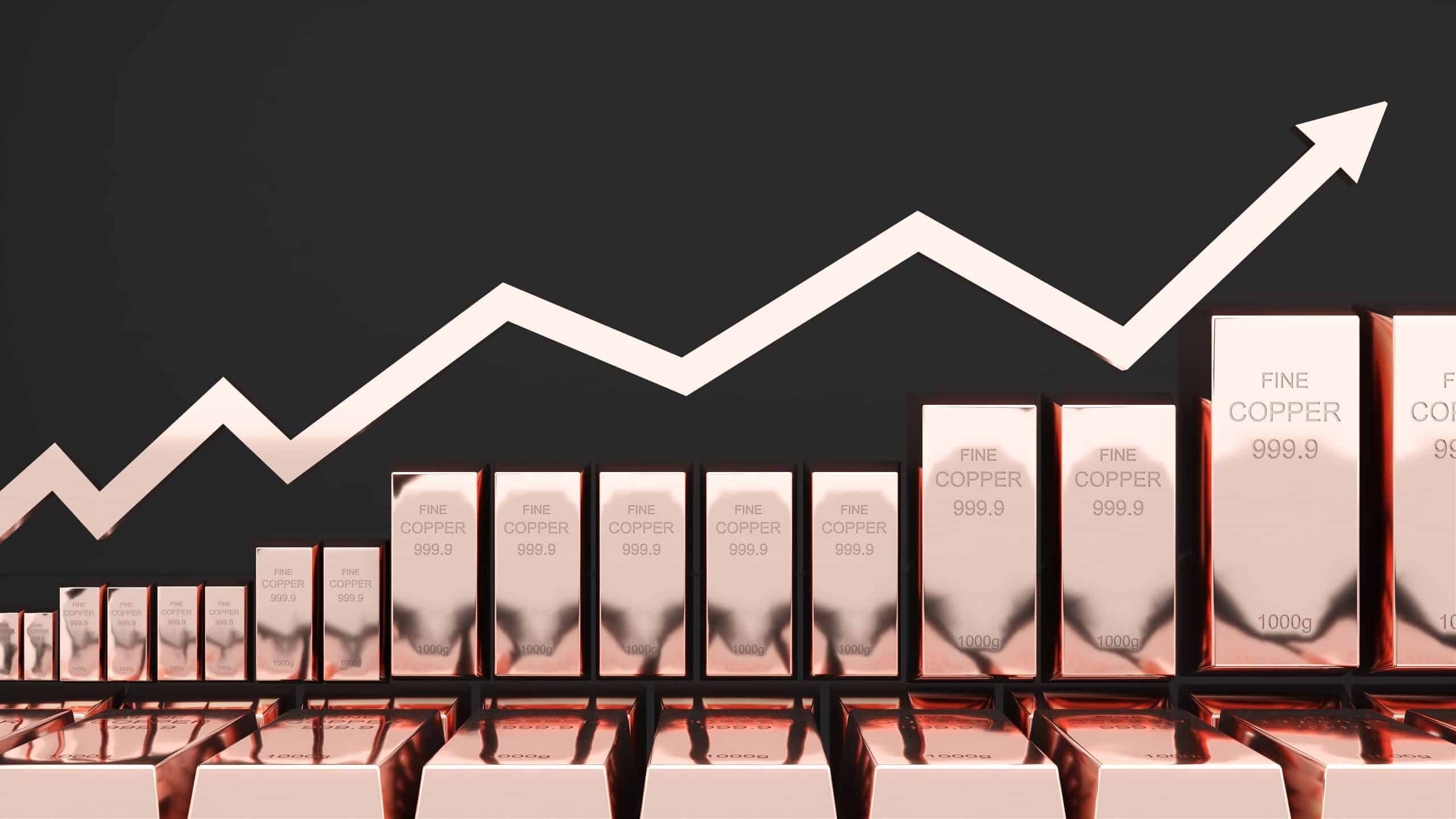Get wired for potential profits and a greener future by investing in copper, the indispensable metal that’s powering the world’s transition to renewable energy.

The Copper Market: An Overview
Copper is the third-most-consumed metal in the world.
It is a highly electrically conductive material and versatile metal. Copper is widely used in various industries, including construction, electronics, and transportation. It is a good conductor of electricity and heat, making it a key component in electrical wiring, motors, and other electrical equipment.
Increasing demand for the use of Copper in automotive equipment, construction, electronics, and telecommunication industries is boosting the Copper market’s growth.
A major driving force behind the increase in copper demand is electric vehicles, which use Copper to construct many key parts of electrical vehicles.
Between 2023 and 2028, the copper market is expected to have a 6% CAGR, according to research from Mordor Intelligence. Furthermore, a recent Wall Street Journal article notes that to meet Paris climate targets, more than $23 billion a year needs to be spent on new copper projects over the next 30 years – this is 64% higher than the average annual copper spend over the past three decades.
All this said, it’s worth taking a closer look at copper investing and whether an investment in this metal could also be good for your portfolio.
Factors That Influence The Copper Market
Several factors, including global supply and demand dynamics, economic indicators, and geopolitical events, influence the copper market.
Copper prices can be volatile due to changes in supply and demand, fluctuations in currency exchange rates, and other factors. The copper market is also subject to speculation and trading activity on commodity exchanges, such as the New York Mercantile Exchange (NYMEX) and the London Metal Exchange (LME).
Factors that influence Copper:
- Supply and demand
- Geopolitical events
- Economic indicators
- Trading speculation
In recent years, the copper market has been impacted by various factors, including the COVID-19 pandemic, which disrupted global supply chains and reduced demand for Copper in certain industries. Additionally, efforts to transition to renewable energy sources, such as wind and solar power, are expected to increase demand for Copper, as it is a key component in constructing infrastructure for these technologies.
Ways To Invest in Copper
If you’re wondering how to invest in Copper, there are several ways to get started, including investing in copper stocks, copper ETFs and mutual funds, copper futures, and even copper bullion.
Below we will review the 5 best ways to invest in Copper.
Copper Stocks
The easiest way for most individuals to invest in Copper is through copper stocks. You can invest in copper stocks through an online brokerage like eToro, which makes it easy to buy copper mining and copper production companies. Additionally, if you do not have much money to invest, you can consider buying fractional shares of these Copper stocks.
Popular Copper Stocks:
While there are countless publicly-traded copper stocks, below are 5 of the more popular publicly traded copper companies.
Freeport-McMoRan Inc. (FCX): Freeport-McMoRan is one of the world’s largest copper producers. The company operates mines in North and South America, as well as Indonesia, and also produces gold and molybdenum.
Southern Copper Corporation (SCCO): Southern Copper is a mining company that produces Copper, molybdenum, zinc, and silver. The company operates mines in Peru, Mexico, and Chile.
BHP Group Limited (BHP): BHP Group is a global resources company that produces Copper, iron ore, coal, and petroleum. The company’s copper operations include mines in Chile, Peru, and the United States.
Rio Tinto plc (RIO): Rio Tinto is a mining company that produces Copper, iron ore, aluminum, diamonds, and other minerals. The company’s copper operations include mines in Mongolia, the United States, and Chile.
Glencore plc (GLEN): Glencore is a commodities trading and mining company that produces Copper, zinc, nickel, and other metals. The company’s copper operations include mines in Africa, South America, and Australia.
Copper ETFs and Mutual Funds
Another great way to invest in Copper is through Exchange-traded funds (ETFs) and mutual funds. Copper ETFs and mutual funds offer exposure to copper-related assets without purchasing individual copper stocks.
Copper stocks and cooper mutual funds are a great way to gain diversification by investing across a wide range of publicly-traded companies.
Popular Copper ETFs and Mutual Funds:
iPath Series B Bloomberg Copper Subindex Total Return ETN (JJC): This ETF tracks the performance of copper futures contracts traded on the COMEX division of the New York Mercantile Exchange.
United States Copper Index Fund (CPER): This ETF tracks the performance of the SummerHaven Copper Index, which is designed to reflect the performance of copper futures contracts traded on the COMEX.
Global X Copper Miners ETF (COPX): This ETF invests in companies that are involved in copper mining, exploration, and production. The ETF includes copper mining stocks from around the world.
iShares MSCI Global Metals & Mining Producers ETF (PICK): This ETF invests in companies involved in metals and mining production, including copper mining stocks.
Fidelity Select Materials Portfolio (FSDPX): This mutual fund invests in companies that are involved in the production and distribution of basic materials, including copper mining stocks.
Copper Bullion
A less common way to invest in Copper is to buy physical Copper, colloquially known as bullion, which can be bought as copper bars, coins, or rounds.
You can buy physical Copper through reputable online dealers who are qualified by the U.S. Mint as “Authorized Purchasers.”
But remember buying physical Copper also requires storage, transportation, and insurance, which can add additional costs and logistical challenges.
For example, physical Copper can be a storage issue for your average investor. Historically, copper prices have been between $2 and $5 per ounce, and 16 ounces are in a pound.
So a $5,000 investment in Copper means you need to store approximately 100 lbs of Copper – certainly not lightweight.
Copper Futures
The last way to invest in Copper is through Copper futures. Copper futures are a type of financial contract that allows investors to speculate on the future price of Copper. Futures contracts are agreements to buy or sell an asset, in this case, Copper, at a predetermined price and date in the future.
Copper futures are traded on commodity exchanges, such as the New York Mercantile Exchange (NYMEX) and the London Metal Exchange (LME). These exchanges provide a platform for investors to buy or sell copper futures contracts, which are standardized in terms of quality, quantity, and delivery date.
Investors can take either a long or short position on copper futures contracts. If an investor takes a long position, they agree to buy Copper at a future date at a predetermined price. In contrast, a short position means they agree to sell Copper at a future date at a predetermined price.
A variety of factors, including global supply and demand dynamics, geopolitical events, and economic indicators influences the price of copper futures. As a result, investing in copper futures can be highly speculative and volatile.
Investors who trade copper futures should have a solid understanding of the copper market and its price drivers and the ability to manage risk effectively. Copper futures trading requires a high degree of knowledge, experience, and capital.
In other words, trading Copper futures is not for beginners.
Benefits and Risks of Investing in Copper
Investing in precious metals like Copper offers many benefits and risks for investors.
Benefits of Copper
Investing in Copper can offer several potential benefits for investors. Here are some of the key benefits of Copper investing:
Diversification
Copper can provide diversification benefits to investors, as it is a commodity that is not highly correlated with traditional stock and bond investments. This means that Copper can help to reduce overall portfolio risk and volatility.
Inflation Hedge
Copper can serve as an inflation hedge, as its price tends to rise during periods of high inflation. This can help to protect investors against the erosion of purchasing power caused by inflation.
Growth Potential
Copper demand is driven by global economic growth, and as emerging markets continue to develop, demand for Copper is expected to grow. This growth potential can provide investors with potential capital gains over the long term.
Renewable Energy
Copper is key in constructing renewable energy infrastructure, such as wind turbines, solar panels, and electric vehicles. Demand for Copper is expected to grow as the world transitions to renewable energy sources.
Risks
Investing in Copper, like any investment, carries risks. Here are some of the key risks to consider when investing in Copper:
Volatility
Copper prices can be volatile, and changes in supply and demand, geopolitical events, and other factors can cause significant fluctuations.
Global Economic Conditions
Copper demand is closely tied to global economic conditions. A slowdown in the global economy can lead to a decrease in copper demand and prices.
Political and Geopolitical Risks
Copper production is concentrated in a few countries, which can be subject to political and geopolitical risks, such as government instability, labor strikes, and nationalization of resources.
Environmental and Regulatory
The copper mining industry can be subject to environmental and regulatory risks, including changes in environmental regulations, permit requirements, and compliance costs.
Currency Risks
Copper prices are denominated in U.S. dollars, so fluctuations in exchange rates can impact the value of copper investments for non-U.S. investors.
Company-specific Risks
Investing in individual copper mining companies carries company-specific risks, such as production disruptions, management changes, and financial performance.
Investing Tips
If you want to become an investor, here are some no-nonsense tips you can follow:
Do your research: Before investing in Copper, it is important to conduct thorough research on individual companies and the broader copper market. This can help you to make informed investment decisions and reduce the risk of losses.
Diversify your portfolio: Investing in Copper should be part of a well-diversified portfolio that includes a mix of asset classes, such as stocks, bonds, and cash. Diversification can help to reduce overall portfolio risk and volatility.
Invest for the long-term: Copper prices can be volatile in the short term, but over the long term, Copper has historically provided solid returns. Investing for the long term can help you to ride out short-term price fluctuations.
Consider using a professional: If you are new to investing or do not have the time or expertise to conduct thorough research on your own, consider using a professional financial advisor to help guide your investment decisions.
Monitor market conditions: Stay up-to-date on global economic conditions, supply and demand dynamics, and other factors that can impact copper prices. This can help you to make informed investment decisions and adjust your portfolio as needed.
Manage risk: Investing in Copper carries risks, so it is important to manage your risk exposure by using risk management strategies such as stop-loss orders and limit orders.
Remember that investing in Copper carries risks, and there is no guarantee of investment returns. It is important to consider your investment goals, risk tolerance, and overall financial situation before making any investment decisions.
The Bottom Line
Investing in Copper is a great way to provide protection against increases in inflation while simultaneously taking advantage of trends in the market, like the use of Copper to satisfy the increased demand for electrical vehicles.
There are several ways to invest in Cooper, and the correct approach depends on your investment style and goals. If you want to easily buy and sell your cooper investments, then Copper stocks, ETFs, and mutual funds are the right choice. However, if you are an advanced trader, then copper futures, or holding physical Copper may be the right choice.
5 best ways to invest in Copper:
- Copper stocks
- Copper Mutual Funds
- Copper ETFs
- Copper Bullion
- Copper Futures

